© 2007 Mike Enyeart, E. Michael Staman, and Jose J. Valdes Jr. The text of this article is licensed under the Creative Commons Attribution-NonCommercial-ShareAlike 2.5 License (http://creativecommons.org/licenses/by-nc-sa/2.5/deed.en).
EDUCAUSE Review, vol. 42, no. 2 (March/April 2007): 46–66
The concept of convergence has evolved significantly during recent years. Today, convergence refers to the integration of the communications and computing resources and services that seamlessly traverse multiple infrastructures and deliver content to multiple platforms or appliances. There are three levels to convergence: infrastructure, appliances, and services. All three work together, with the ultimate goal of allowing access to—and the delivery of—any service to any appliance, to and from anywhere and over any medium, be it wired IP (Internet Protocol), wireless IP, or mobile cellular devices.
In the convergence model, voice becomes just another data service. Other services—such as messaging, video, and pictures—are equally important. In the voice world, we are moving to a consolidated IP backbone. And 3G (third-generation) cellular technology delivers high bandwidths, capable of supporting simultaneous voice, multimedia, and data in meaningful ways. Mobility is a key factor and must be considered in any convergence strategy.
Convergence is real. Those in higher education, and especially those in campus IT organizations, need to understand the trends in order to structure their services as the future evolves.
Strategies for Convergent Services
To outline some of the current trends in convergence, the EDUCAUSE Net@EDU ICS Working Group1 (http://www.educause.edu/IntegratedCommunicationsStrategies/930) recently conducted a short survey of a targeted group of higher education institutions.2 The responses to this survey helped inform the following discussion of several basic parameters: why convergence is being pursued in the first place; the extent to which organizational structure has evolved to accommodate converged infrastructure and services; the extent to which colleges and universities have actually deployed converged services; some inhibitors to convergence; examples of applications; the economics of convergence; and new educational opportunities.
Reasons for Pursuing Convergence
Primary reasons for pursuing convergence are to achieve operational efficiencies and to provide additional or enhanced services (see Chart 1). One institution reported: "We view converged applications as next-generation services. Our 'customers' are increasingly leaving behind the campus Centrex offerings in favor of innovative wireless and VoIP services. Our university feels it is important to control the communications." In addition, an organization perspective crept into the comments: "I am more concerned about convergence of personal and business applications than technology convergence."
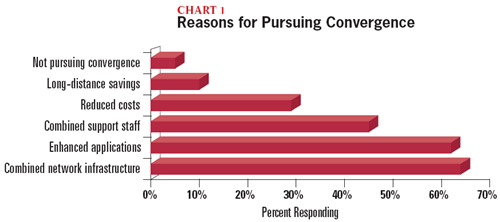
Click image for larger view.
Organizational and Financial Planning
Colleges and universities are struggling with convergence financial models as they begin restructuring their organizations, operations, and policies to reflect convergent services (see Chart 2). They appear to be implementing convergent services within their existing financial models. Only 10 percent reported having an actual financial model for convergent services in place; a much higher percentage has indicated that they are pursuing convergent services.
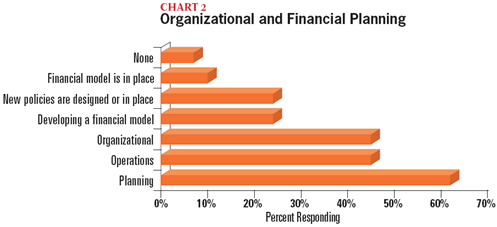
Click image for larger view.
One reason for the lack of a financial model may be the still evolving impact of convergence on organizational structure and operational costs. For example, combining support staff and/or reducing costs by eliminating redundant physical infrastructure for voice, data, and video services may realize savings. Of the institutions responding to the survey, 45 percent indicated that they have restructured either operations or their organization (or both) in a manner designed to take advantage of convergence; thus, pricing for VoIP (Voice over IP) may reflect a balance of savings and expenses for convergent services. Further investigation is warranted to determine how the convergence model affects the financial model.
Actual Deployment of Convergent Services
At this stage, deployment is focused on trials and early implementations of voice, videoconferencing, and video-streaming solutions (see Chart 3). VoIP is being deployed primarily in concert with existing legacy systems. Some institutions have deployed VoIP services with the objective of replacing traditional voice services. In addition, a number of the tasks are likely occurring in parallel—for example, talking to vendors, technical trials, and planning.
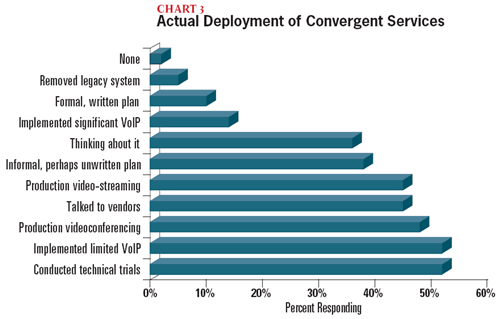
Click image for larger view.
Inhibitors to Convergence
Cost and infrastructure requirements are the top inhibitors (see Chart 4). But institutions are expending resources on convergence when there is a justifiable application. Evidently, VoIP and video services are the most-justified convergent applications. One respondent commented: "Our current infrastructure is robust and capable of supporting known and anticipated needs for voice, data, and video services. The new voice system is a hybrid capable of analog, digital, and IP." Another stated: "I view our next step in convergence as the merger of personal cell phones and campus communications services."
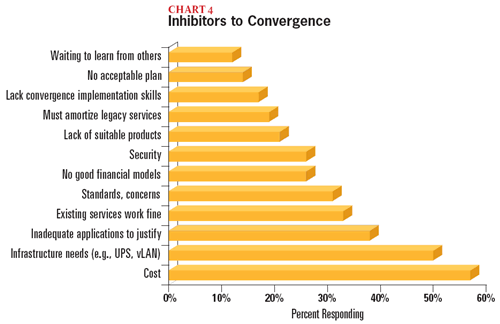
Click image for larger view.
Interestingly, a lack of skills in the convergent technologies is one of the lowest-reported inhibitors to convergence (17%). Institutions pursuing convergent services have apparently structured accordingly. Thus, the combined skills sets of IT and telecommunications staff may be sufficient to support the current state of convergent services on most campuses. One could surmise, however, that the rate of implementation of convergent services at an institution is directly related to the mitigation of the inhibitors reported and the skills of the staff needed to implement the services.
Not surprisingly, responses to queries about the nature of convergence inhibitors raised additional questions. For example, because convergence encompasses multiple technologies, it would be valuable to further explore whether one technology or another is perceived as particularly cost-prohibitive. Can we assume that the costs are warranted because of the long-term savings, benefit, and/or demands of the institution?
Convergence Applications
Consistent with other indicators in the survey, voice and video applications predominate in the current application space (see Chart 5). New VoIP systems, not VoIP-enabled legacy PBX systems, are the clear leader of convergence applications at this time.
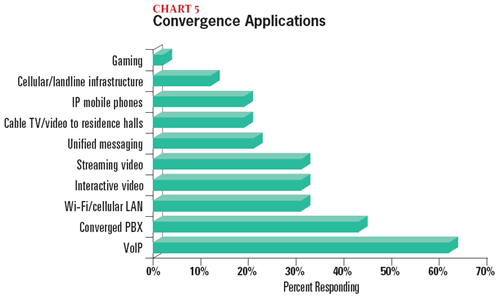
Click image for larger view.
Financial Issues
Today, IP network access is either free to end users or substantially subsidized (often by telephone rates) at many colleges and universities. The resulting situation is an economic distortion that provides an incentive for end users to use outside VoIP services, since they view this as "free" telephone service.
Most institutions reported that they have no idea how much outside VoIP services are being used on their campus nets. Campus customers are expressing strong interest in "free" VoIP (e.g., Skype), particularly for international calling. Most colleges and universities see little new in this issue, since their traditional service has been decimated by cellular telephones and e-mail. Several institutions reported that they have measured an average of 1–6 Mbps (approximately 10–50 simultaneous voice conversations) of VoIP traffic, mostly from the student population.
This local (customer-centric) optimization can cause several problems from the organizational viewpoint. Some problems may involve economic issues, such as the need to dramatically increase expensive PBX trunking to the public telephone network to complete calls from non-university VoIP telephones/softphones deployed on the campus. Other problems from the organizational viewpoint may involve strategic issues, such as the potential disintegration of a mission-central asset, or the possible loss of policy controls in areas such as safety and procurement.
In response, some colleges and universities plan to price IP service relative to true cost. They are also examining the bundling of IP voice, video, and emerging services. Some institutions are moving away from a cost-recovery model and toward a utility model, using a fee to provide baseline IP and telephone services and charging only for advanced or custom services.
Only 15 percent of the survey respondents charge differently for VoIP than for legacy telephone services. This fact is interesting because some VoIP systems (e.g., Asterisk with eyeBeam softphones) can be installed at significantly lower cost. On the other hand, the cost of some other commercial VoIP systems approximates the cost of legacy telephone service. Telecommunications departments may be hesitant to offer lower-cost VoIP service because of concerns that doing so might cannibalize income margins, especially if a legacy PBX is not fully depreciated. But it could also be that the VoIP cost model is complex or nebulous; thus, implementing it with an existing price model is simpler. Another possibility is that the prevailing cost model is being sustained in order to avoid the administrative and/or political "fallout" of a new cost model for basic telephone service.
VoIP turns out to be insignificant with respect to long-distance revenue issues because that revenue stream has been obliterated by cellular telephones and e-mail in the student long-distance market segment. In the administrative long-distance market segment, the profit margin is negligible. Internationally, there is little impact, in part due to the fact that international rates (and profits) have dropped significantly in the last few years.
At the same time, there are new revenue opportunities. One approach is to focus on reversing the loss of market share by reforming the telephone revenue model based on implementing a utility-pricing model versus a cost-recovery one. In addition, there are new market possibilities: competitively priced VoIP and new services such as IPTV (cable TV replacement) and video-on-demand (both entertainment and college/university collections); the development of advanced services, such as custom call-center applications; new distribution systems, such as campus cellular services or antennae; security systems, such as photo applications; enhanced directory services (supporting integrated multiple communication mediums); and the deployment of integrated collaboration tools.
At the moment, institutions appear to have little interest in pursuing new markets off campus, such as offering telephone service or entertainment services to off-campus students, an offering that could be enabled by generic high-speed or broadband network access. Institutions perceive new market opportunities as being within the campus and limited to the delivery of core services (education) in support of institutional missions using emerging telecommunications technologies.
New Educational Opportunities
Convergence provides new opportunities to deliver education by focusing on technologies such as podcasting, videoconferencing, online collaboration, multimedia service delivery, video-on-demand, and integration of Wi-Fi with cellular. New, or enhanced, services include interactive distance education, collaborative instruction, international interaction (particularly for foreign languages), streaming foreign-language video, remote access to college/university media collections, and new educational content development.
VoIP and VoIP Strategies
At the moment, VoIP is the predominant driver in the convergence arena. Although VoIP has penetrated less than 5 percent of the production/operations at institutions, VoIP is overwhelmingly viewed as the long-term direction for providing telephone service. Planning, direction, organization, and implementation strategies are moving forward, with 80 percent of institutions confirming a long-term strategy for VoIP (see Chart 6). Organizations are now developing the prerequisite infrastructure for VoIP deployment. IP trunking and desktop integration of IP voice, IP videoconferencing, integrated directory, IPTV, Instant Messaging, presence, and collaboration tools are driving IP convergence.

Click image for larger view.
Production deployment of VoIP services is beginning to occur. From the survey, 8 percent of respondents reported that at least some desktops (typically less than 25%) now have VoIP as their telephone service. In addition, 25 percent of institutions reported that they are now in the process of deploying IP connections (trunking) to a VoIP PBX that supports either POTS or vendor-proprietary digital telephone instruments at the desktop. And 33 percent have reported the use of IP tie-line connectivity between remote sites and/or the use of IP trunking with commercial service providers. Finally, VoIP has created significant changes in voice-deployment strategies over the past three years (see Chart 7).
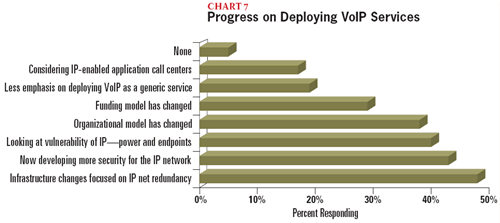
Click image for larger view.
VoIP Security
It is impossible to consider convergent services today without discussing security. In the survey, security concerns occurred in three broad categories: governmental, system, and personal.
Governmental security is manifested as compliance with the Communications Assistance for Law Enforcement Act (CALEA) of 1994. There has been extensive discussion about CALEA elsewhere.3 System security includes fraud protection; the requirement for the protection of dial-tone assets from network attacks using VLAN, VPN, WEP, and/or firewalls; and concern about some "vulnerable" VoIP operating systems. Personal security involves the use of encryption to provide authentification and protection from eavesdropping. It also encompasses life and safety concerns related to Enhanced 911 (E911 automatically sends the caller's location to the 911 operator), particularly for mobile devices, cellular, Wi-Fi and softphones.
A number of specific comments from survey respondents reinforced these security concerns:
- "Security, reliability, and stability are all considered inhibitors to VoIP at this point. Our IP network was not engineered for converged services and is not considered capable of providing such services in highly reliable ways."
- "While security challenges exist today, the opportunity exists to make voice communications more secure over IP in the long term than they are today in legacy telephony."
Emergency Call Processing
Many colleges and universities are concerned about the effective delivery of emergency services—specifically about the legal liability and the moral/ethical responsibility to effectively respond to emergency situations on campus.
There are two distinct issues involved here: the "911 issue" and the "E911 issue." The 911 issue concerns call completions to the correct Public Service Answering Point (PSAP), which is staffed by 911 operators. Correct call routing is especially problematic for mobile phones and computer-based softphones. (Imagine what could happen if a faculty member made a 911 call from a campus softphone while attending an out-of-state conference and the call was routed to the campus PSAP.) The E911 issue regards the automatic delivery of the correct location of the caller to the PSAP. Again, this is problematic with today's movable telephones. Both issues are being addressed by elements of the higher education community and by the telecommunications industry through an FCC mandate for accurate location information for mobile devices. But until the problems are resolved, institutions are using policies such as static IP addresses and/or the transfer of liability to end users by enforcing agreements similar to those used by VoIP service providers. Other institutions are educating users about the issues.
911 regulatory responsibilities are largely vested in state governments, which may account for the variety of survey responses on this issue. For example, one respondent reported that the institution does not complete VoIP calls to 911. Another candidly stated that the institution doesn't "do such a hot job [handling E911] with the TDM [legacy PBX] system." Yet another said that the institution is sticking its "head in the sand." Today, as noted, this issue is largely addressed by "locking down" VoIP telephones to a specific location.
Disaster Planning
Colleges and universities seem generally enthusiastic about using IP for disaster recovery as an alternative or a supplement to cellular telephones. Specific solutions included using the IP network as an alternate route to the public switched telephone network (PSTN), rapid service (end-point) deployment, redundant trunking (a mix of legacy TDM and VoIP trunks), and geographic dispersion of call processors (VoIP cluster servers).
Applications and Users' Response to VoIP
Some institutions are looking for the "killer app." One reported that the integration of voice mail with e-mail through Asterisk (an open-source PBX) seems to be such an application. Others highlighted presence management and an integrated desktop (supporting a full range of media types under a single contact directory). One university reported: "It really breaks down to age groups. [Those] under [age] 35 are all over VoIP, IM, and other related services."
The reaction of faculty and staff to VoIP is generally neutral, characterized by respondent's comments such as the following:
- "Very few VoIP users even know that it is VoIP."
- "They like it if they're moving off campus and it enables them to retain their university phone number. Otherwise they're indifferent."
- "They like it but don't want to pay more for it. Why should I pay anything for it when I can get Skype for free?"
- Most customers "just want their phone to work."
The lack of an overt reaction to the VoIP service by faculty and staff seems appropriate when VoIP is used to deliver "basic dial tone" and nothing else. The major implications are that unless other services are provisioned with VoIP and/or unless VoIP proves to have obvious financial or operational advantages, faculty and staff will demonstrate little resistance to or interest in VoIP. The salient questions become whether they are willing to pay more for the additional functionality and whether additional functionality can be provided at the same price.
Campus Policy Issues
Campus VoIP policies, at least those that exist, focus on the indiscriminate relocation of VoIP instruments because of safety concerns (e.g., 911 call processing). Interestingly, institutions are evidently deploying VoIP without producing unique policies for the service. This observation seems to correlate with the fact that institutions are adopting existing legacy telephone pricing models to the VoIP paradigm. In other words, extension of the status quo is the norm.
But there is a question of whether institutional central administrations will somehow attempt to prevent the proliferation of ad hoc VoIP use through policy mandates, service bundling, or financial controls. Survey respondents commented:
- "I don't know that we should prevent it. Rather, perhaps our goal should be to encourage it. We are considering a stipend proposal for cell phones and handheld devices. In the future it may make sense to follow this line of thinking for phone services."
- "The philosophy followed is to entice use through added value compared to that otherwise available. It is unlikely that edicts against actions will be embraced unless there is strong financial or pedagogical reason to do so."
- "We'll try to control, but it will only make users resent us, especially if they can get better service at home for cheaper. Many of our customers run their own VoIP at home! Providing more value and a flexible business model is preferable to attempted control."
- "You can only beat them on service and price. If you can't, then why are you in business?"
When survey respondents were asked whether the proliferation of cellular telephones on campus might eliminate the need for office desktop telephones within the next five years, 79 percent said no. Cellular telephones have the seemingly insurmountable problem of small display screens and limited bandwidth versus desktop telephones or laptop computers. Since desktop telephones appear to be a constant for the foreseeable future, better integration of cellular telephones with landline and desktop systems is highly desirable. (Perhaps this model is not much different from the "future" model envisioned in the Star Trek television and movie series—personal, portable communication devices supplemented with large communication devices.)
In response to the question of whether institutions would directly provide any voice service or long-distance service ten years from now, 85 percent of respondents answered "yes":
- "Mandates for E-911 emergency service (to our own campus police station) will preserve our monopoly for most of our desktop phones, although the numbers could get more sparse. We will certainly offer on-campus call management; long distance may become irrelevant."
- "Long-distance service as a separate metered service will probably die, as it will probably become viewed like local service as distance becomes less of a concept in the 'modern' networked world. It will simply become part of the monthly flat fee."
- "For complex institutions, it seems likely that there will be needs that can only be met through internal development and application, necessitating continued internal management of the related services. There also will continue to be value to aggregating telephone services."
- "Voice is simply another network application. If we still provide network services, voice will be running over that network."
- "As an employer, we're obligated to provide our employees with the tools they need to do their jobs, and I expect a basic desktop appliance will typically be cheaper in TCO and perform better than the wireless alternatives."
Policy issues cut to the heart of future campus service. On the one hand, some campus telecommunications organizations seem demoralized by the revenue loss over the past ten years and are resigned to further loss of market share. Others insist that a reliable campus telephone service is essential to the business functions of the institution and is therefore a strategic asset that must be protected by restructuring the financial and/or policy mechanisms. A third set envisions the future and sees innovation driven by competition, emerging academic requirements, and the changing expectations of end users. For this group, the focus is on application innovation—for example, bundling (multimedia campus directory service, IPTV, collaboration tools, middleware, cellular/Wi-Fi integration) and building on the concept of a community of scholars that will forever be at the forefront of value-added IT innovation. The future may be a mix of all three perspectives.
Achieving the new economy of scale inherent in VoIP locally may be possible only at the grassroots level—using, for example, open-source software and/or higher education federations. The new economy of scale has moved from a telephone switch providing a few thousand lines within a radius of a few miles to a cluster of processors providing millions of lines without geographic limitation.
What about the Future?
The years 2009 and 2010 are apparently going to be significant for VoIP. Of the survey respondents, 42 percent predicted that VoIP would provide at least 50 percent of the campus telephone services during one of those two years; 10 percent of respondents stated that the 50 percent threshold would be reached after 2010; 38 percent gave no date. This is consistent with industry expectations. It should come as no surprise that although there have been no public announcements, PBX vendors are now attempting to develop time frames for ending product support for non-IP-enabled (upgraded) PBXs.
Colleges and universities have traditionally provisioned and managed telecommunications services centrally, essentially preventing commercial telecommunications service providers from provisioning ad hoc subscription services. The proliferation of low-cost or free VoIP services from service providers may have a drastic effect on the traditional college/university service model. The survey results were split on this potentiality. About half of the respondents envisioned an increase in ad hoc subscription to low-cost or free commercial VoIP services:
- "Cell phones have already eroded the monopoly. Services like Skype more typically draw away long-distance revenue, but not necessarily desktop instruments. The mandated need for effective E911 emergency calling may protect much of the monopoly."
- "I have dropped my Centrex line and use Vonage softphone service for personal and business calls." (This is from a campus telephone service provider!)
- "Anyone who thinks they can monopolize voice has their head in the sand. Instead, we are focusing on building a business and service model that makes our services more attractive but can work with third-party services so that those don't become a threat."
- "We already are seeing pressure in this area. Individuals getting their own accounts. Departments deploying their own VoIP infrastructures."
And about half of the survey respondents replied that there would be no impact on the college/university telecommunications services:
- "We've not seen any real use of non-university systems due to lack of enterprise features such as enterprise voice mail."
- "The principles driving the migration to 'free' services are contrary to the need to apply true economies of scale to the centrally managed services. Ad hoc external subscriptions to 'free' services have the effect of increasing the overall telecom costs."
- "Students won't use it. Faculty and staff still have to have our phones in order to be in our directory. The budget process for allocating funds to telecommunications requires those funds be spent on university-provided or approved services."
- "Faculty and staff want high-quality, simple-to-use service."
The challenges faced by campus telephone service providers are not unlike the challenges faced by commercial telephone service providers, who are increasingly bundling legacy telephone service with high-speed Internet access as well as unlimited long-distance and entertainment services. (It should be noted that the policies of telecommunications providers may be affected by competition and regulatory changes.) Most colleges and universities have implemented this model, albeit in reverse. Many bundle Internet access with telephone service. In other words, if a customer buys telephone service, part of that fee pays for Internet access (which may also be subsidized), but if a customer does not buy telephone service, he/she can still have Internet access for free. This economic model provides a powerful incentive for customers to pursue alternative VoIP service.
In response, some institutions are implementing a mandatory fee that provides each end user with a bundle or package of communication services.4 This strategy is based on the principle that each person affiliated with the college or university inherently needs communication capabilities and that those services should be optimized globally for the institution. Bundled fees are typically assessed at high levels on the chart of accounts (i.e., major administrative units at the vice president or dean level) to reduce processing costs.
An interesting parallel is the use of free e-mail service versus institution-provided e-mail service. Services such as Gmail often provide significantly more storage than campus systems, and even though most colleges and universities allow students to point their campus e-mail address at outside e-mail accounts, this is seldom done in practice. This begs the question: what do students value in campus e-mail accounts? The answers seem to be that students value their campus identity (individually and collectively); they rely on campus directory services; and they value reliability, confidentiality, and security. Students may also prefer a campus e-mail account because of the frequent mandate that e-mail be used to support the business functions of the institution, with students held responsible for processing official communications sent by e-mail.
Conclusion
All of these issues are overshadowed, to some degree, by the relentless progress of technology. We are evidently on track for the consolidation of all forms of personal communication. Directories are becoming unified; identity convergence is reconciling dial plans; and e-mail addresses may soon become the equivalent of telephone numbers, providing a single syntax for communicating with others. "Value-added services" are a natural result of convergence.
Without a doubt, voice is now generally viewed as simply another application that runs over a multiservice network and eliminates the long-distance per-minute charge concept. Furthermore, the widespread deployment of alternative communication modes (e.g., cellular, IM) has lessened the need for a perfectly reliable telephone system and has demonstrated that users will trade reliability for other perceived values (e.g., mobility). Thus, the future seems set to replace traditional telephone service with computer-based softphones coupled with miniature wireless (e.g., Bluetooth) ear sets that are integrated with wide-area wireless (cellular) service. If traditional telephone service survives in higher education, it will be largely limited to providing 911 and other specialized services in high-traffic and common areas, just as pay phones once did. Clearly, some higher education leaders are busy building the prerequisite organization, infrastructure, and applications to lead this evolution.
1. Interested individuals can join the ICS Working Group and participate in its activities. Correspondence may be directed to the authors or to any of the members of the steering committee.
2. The survey was sent to 50 institutions; 42 responded. When we discuss survey results, readers should consider the analysis as representative of conversations that would occur at a national meeting of individuals interested in integrated communications strategies. Comments from the survey are reflective of the status and progress of those working on the problem and tend to be weighted in favor of large, R-1 universities. The survey sample set had the following characteristics (figures are averages and have been rounded): total number of students, 29,000; number of faculty and staff, 9,000; number of legacy telephone sets, 15,500; number of legacy video outlets (coax), 3,400; number of wireless access points, 8,000; number of data ports, 32,000.
3. For more information, see the EDUCAUSE Resource Page on CALEA: http://www.educause.edu/Browse/645?PARENT_ID=698.
4. These packages may include a combination of the following and perhaps additional services: a desktop telephone, perhaps a wireless telephone or radio with or without a desktop telephone, voice mail, unlimited domestic long-distance service, presence management, Internet access, an e-mail account, IM services, multimedia directory services, identity management, authentication and authorization services, DNS, other middleware, volume-licensed software, collaboration tools, access to free (and legal) music collections, conference bridges, videoconferencing, broadcast television, premium television (movie channels), perhaps IPTV, consortium television (e.g., Open Student Network Television), and video-on-demand (e.g., college/university collections).
